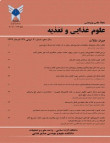Exergetic Comparison of Manufacturing Options in the Traditional Bread Supply Chain
The increasing trend of food waste is one of the serious challenges in mostcountries, especially developing countries, to meet the sufficient food needs of society. In thisstudy, the thermodynamic performance of two traditional bread production chains isexamined. These two chains contain the fresh bread production and the double-baked breadproduction chain (without waste).
The calculations are based on the processing of 1000 kg of doughfor all eight bread chains. Lavash, Barbari, Tafton and Sangak breads produced had a mass ofabout 0.145, 0.410, 0.220 and 0.500 kg, respectively. In order to make an exergic comparisonbetween the bread production chains, the moisture content in both technologies for all Lavash,Barbari, Tafton and Sangak breads were 9.5, 34.1, 19.9 and 17.8 percent, respectively. Dataanalysis was done using two software “ees” and “ e! Sankey “.
The chemical exergy flows were found to be much larger than the physical exergyconsumed in all the bread chains studied. In the traditional bread production chain, lavashbread, baked twice, with the amount of 78.52%, Sangak with the amount of 76.06%, Barbariwith the amount of 70.64% and fresh Sangak bread with the amount of 70.29% had the bestexergy performance. The lowest total lost and irreversible exery were found in 1000 kg ofprocessed dough in the following breads: double-baked Lavash with the amount of (2910megajoules), Sangak bread with the amount of (3288 megajoules), fresh Sangak bread withthe amount of (3862 megajoules). And Taftoon bread double-baked (3921 megajoules).Lowest specific exergy loss and best thermodynamic performance was observed in doublebakedLavash bread (3.80), Sangak bread (3.91), Tafton bread (5.23) and Barbary bread(5.24), respectively. Combining exergy analysis and its application in the field of supply chainmanagement and management sciences are among the innovations of the present study.
Most of the energy loss (non-material) occurs during the cooking, cooling, andfreezing stages. Therefore, any progress in the production of traditional bread should befocused on the design of effective thermodynamic processes of these three stages and the useof appropriate technologies.
- حق عضویت دریافتی صرف حمایت از نشریات عضو و نگهداری، تکمیل و توسعه مگیران میشود.
- پرداخت حق اشتراک و دانلود مقالات اجازه بازنشر آن در سایر رسانههای چاپی و دیجیتال را به کاربر نمیدهد.



